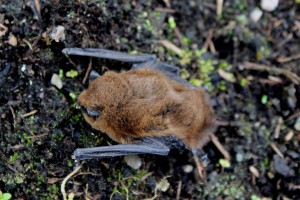 Despite the fact that some animals in the Highlands are nocturnal such as the badger, pine marten, hedgehog and fox, we still know a fair amount about them in terms of their distribution and behaviour. The same can be said of those animals readily seen during the day such as brown hare, red deer and roe deer. However, one group of animals we know less about than any of the other groups are the various bats. In some ways this is not surprising as they are difficult to get to grips with. Most of them are strictly nocturnal, although the pipistrelle bat is often seen flying in the daylight before the light fades. One method of seeing them is to wait until the bats emerge from their daytime roosts such as in houses. However, the bats are difficult to identify when they are flying around and their call notes are often too high pitched so you need a machine to lower this to within our range. Looking at roosts in roof spaces is not an option as you need a special licence to disturb the bats and that includes even looking at them in a daytime roost.
Despite the fact that some animals in the Highlands are nocturnal such as the badger, pine marten, hedgehog and fox, we still know a fair amount about them in terms of their distribution and behaviour. The same can be said of those animals readily seen during the day such as brown hare, red deer and roe deer. However, one group of animals we know less about than any of the other groups are the various bats. In some ways this is not surprising as they are difficult to get to grips with. Most of them are strictly nocturnal, although the pipistrelle bat is often seen flying in the daylight before the light fades. One method of seeing them is to wait until the bats emerge from their daytime roosts such as in houses. However, the bats are difficult to identify when they are flying around and their call notes are often too high pitched so you need a machine to lower this to within our range. Looking at roosts in roof spaces is not an option as you need a special licence to disturb the bats and that includes even looking at them in a daytime roost.
One valuable source of information about bats and, for that matter, other animals in the Highlands is the invaluable “Atlas of Highland Land Mammals” edited by Ro Scott and published in 2011 by the Highland Biological Recording Group. Fortunately, this covers the seven types of bats to be found in the area and this out of the 16 resident bats that are to be found in Britain. Despite the restrictions on people without the appropriate licences to look at bats, there are still ways in which we can help. One is to put up batboxes which many of the bats will use. In theory you can put a hinged lid on the top but again you are not legally able to look at the bats as that is technically disturbing them. However, the satisfaction of knowing you can help this endangered group is more than enough. Bats are endangered because their food levels, insects, have gone down drastically with the increase in chemicals and the there is also the lack of breeding sites. All too many older houses have undergone renovation, illegal if bats are present, that is detrimental to bats. New houses just do not incorporate facilities for bats unless the new owner raises the subject as the house is being built.
In a sense then, bats and ourselves live different worlds and do not meet but there is always the exception and one such case happened to me last week. It was in the middle of the day when I walked down the garden and fortunately I just avoided treading on a small bat just lying in the middle of the path. The photograph shows just how tiny the bat was and it is an adult pipestrelle bat. They breed in the roof space of the house along with even larger numbers of brown long-eared bats although I have not looked at them for many years. We can occasionally hear them in the loft and see them at dusk. This is either when they just emerge from the roof or when they are hunting insects before it really gets dark. As for the pipistrelle on the ground it was, technically, illegal for me to touch it but common sense must prevail. I put on some thick gloves, to prevent being bitten, and lifted it up and placed it under the eaves roughly where I knew the bats came out. It was gone the next morning.
Tags: highland wildlife
